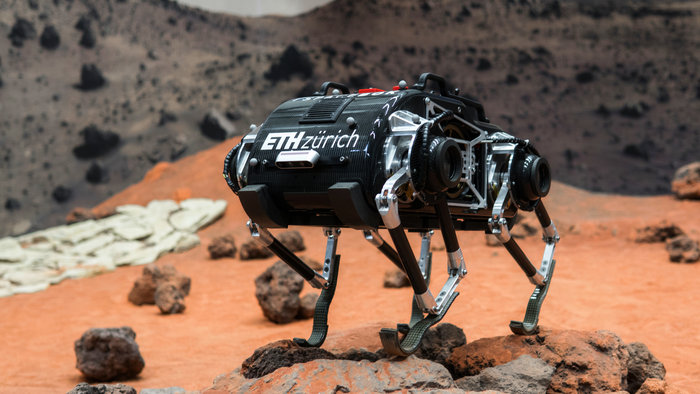
If you’ve ever looked at astronauts on the moon jumping high in the air and thought that looked like a great way to get around, you’re not the only one. The European Space Agency has created SpaceBok, a bouncing robot designed for low-gravity “dynamic walking” inspired by the gait of the springbok.
“Instead of static walking, where at least three legs stay on the ground at all times, dynamic walking allows for gaits with full flight phases during which all legs stay off the ground,” PhD student Hendrik Kolvenbach from ETH Zurich’s Robotic Systems Lab explained in a statement. “Animals make use of dynamic gaits due to their efficiency, but until recently, the computational power and algorithms required for control made it challenging to realize them on robots.”
This type of movement is ideal for propelling the bot around non-Earth environments with low gravity. “For the lower gravity environments of the Moon, Mars, or asteroids, jumping off the ground like this turns out to be a very efficient way to get around,” Kolvenbach said. On the moon, for example, SpaceBok could potentially jump as high as two meters (6.5 feet) into the air.
But there’s a challenge with bouncing so high — the robot has to land again safely. To achieve stability in the air, the team uses a system called a reaction wheel, which is similar to what satellites use to control their orientation. The reaction wheel can accelerate or decelerate to create the opposite reaction in the SpaceBok, pushing it into the correct position.
Another clever feature of the bot is its springy legs. Within each leg is a spring which stores energy when the bot lands, and releases it again at takeoff. This makes the bot more energy efficient in its jump.
Testing a robot for low gravity conditions isn’t easy here on Earth. To simulate the low gravity of the moon, the team used the ultra-smooth floor, called Orbital Robotics Bench for Integrated Technology (ORBIT), at ESA’s Orbital Robotics and Guidance Navigation and Control Laboratory in the Netherlands. When the bot was placed onto a free-floating platform, it could simulate the movements of low-gravity conditions by bouncing and sliding along the floor.
The next phase of testing is to get SpaceBok out of the lab and into the real world, testing jumps over obstacles and movement through hilly terrain.



